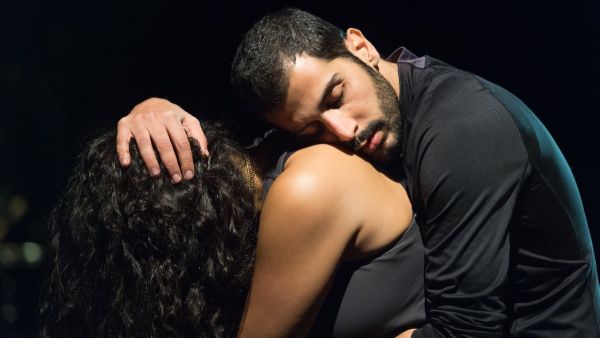Ali Chahrour lies motionless atop a tower of black instrument cases, a bouquet of withered flowers clutched in his hand hanging over the side.
Four other performers stand below, making up a small band. After an overlong silence, Chahrour’s latest dance performance, “Night,” began with Hala Omran’s strong vocals in ancient Sumerian and a tinkling of guitar notes. Perfromed Wednesday evening at Masrah al-Madina, “Night” is the first in a new trilogy of dance works exploring love.
They follow Chahrour’s first trilogy (“Fatima,” “Leila’s Death” and “May He Rise”) which addressed the rituals of death, mourning and the body in the Arab world.
Also based on Arabic tradition and literature, the new trilogy will address the different levels and complexities of passion. It explores the transformation of the concept of love and the ways of expressing it from Al-Jahiliyyah (before Islam) through Islam, to contemporary society.
The stories meant to be referenced in the performance include “Masare’ Al Ishshaq” (Deaths of Lovers), first published in 1907 by Abi Mohamed Jaafar Ben Ahmad Bin Hussein Al-Seraj Al-Qaree.
This collection is comprised of tales of lovers who were consumed by passion, and died for love. These are stories of people near death, uttering poetry with their last breath.
In one chapter he recounts a poet’s final moments, recollecting his lover from their first meeting to the moment he died for love.
On stage, these grand notions translate quite loosely. Prevalent in the choreography is the notion of lovers striving to create new beginnings, only to be torn apart.
After the musical introduction, Chahrour is joined by Aya Metwalli, who abandons the microphone and mimics his repeated, slow, rolling movement. As the tempo picks up, the dancing becomes frantic and jerky. At times they converge toward each other to link arms, at others they’re draw away to suffer alone.
Omran’s vocals join the fray and as the song comes to a close she sticks an arrow shaft into Metwalli’s character slain by Eros’ own arrow while Chahrour embraces her.
The next scene shows Metwalli moving around Chahrour in short shuffling steps, trying to coax a reaction from him. Once more, the dance echoes the increasing tempo.
Metwalli takes Chahrour’s arm and uses him as a pivot, while trying to drag him from his spot, the vocals growing more broken, eventually becoming a scream. Finally all three throw themselves to the stage.
Other numbers play with zaghalit a celebratory trilling sound vocalized by women at weddings and the like turned into an ominous, ghostly sound as they pace the stage.
The performance ends with Omran laying at the front of the stage, seemingly dead, while the others weave the withered flowers through her hair and clothes.
The scene may be a tribute to those who have died in the name of love, or perhaps a warning to those who give up too much for passion.
Though “Night” is pitched as a dance performance there is little dancing, as conventionally understood. The score plays a more obvious role sometimes chanted poetry, other times songs of doomed lovers with Omran’s vocals setting the tone for each scene, more than the seemingly random, repetitive movements of the dancers.
The choreography and music are so allusive, the link between the goals Chahrour expresses in his artist’s statement and what’s seen on stage is difficult to detect, though perhaps things will clarify in the next two installments of the trilogy.
Overall the performance is undoubtedly thought-provoking and requires a careful eye to pick apart all the layers Chahrour has woven together. No date has been set for the next two pieces but those curious about his practices will want to see how they fold into his plan, hopefully answering a few of the questions posed by this first installment.
“Night” is showing at Masrah al-Madina, Hamra until Jan. 27, 8:30 p.m.
This article has been adapted from its original source.








